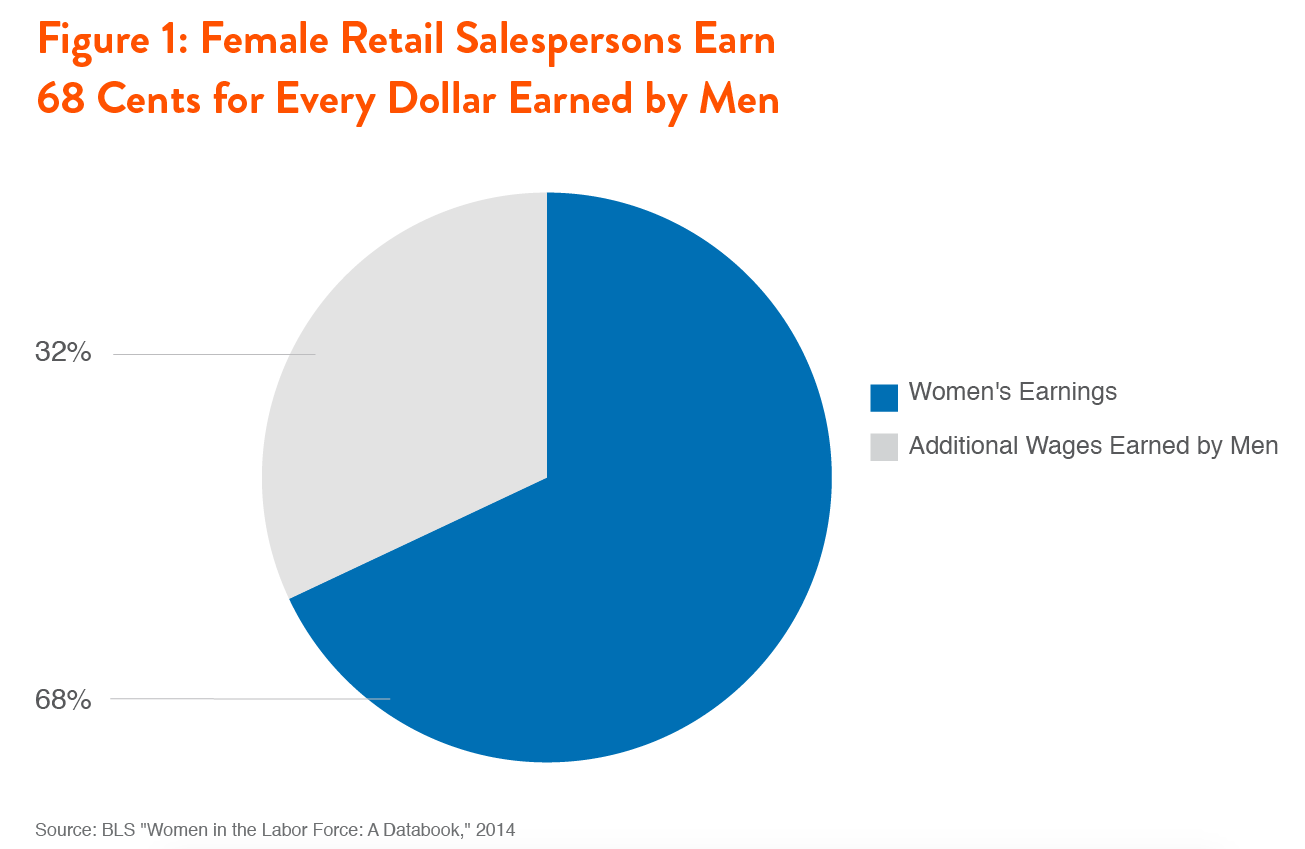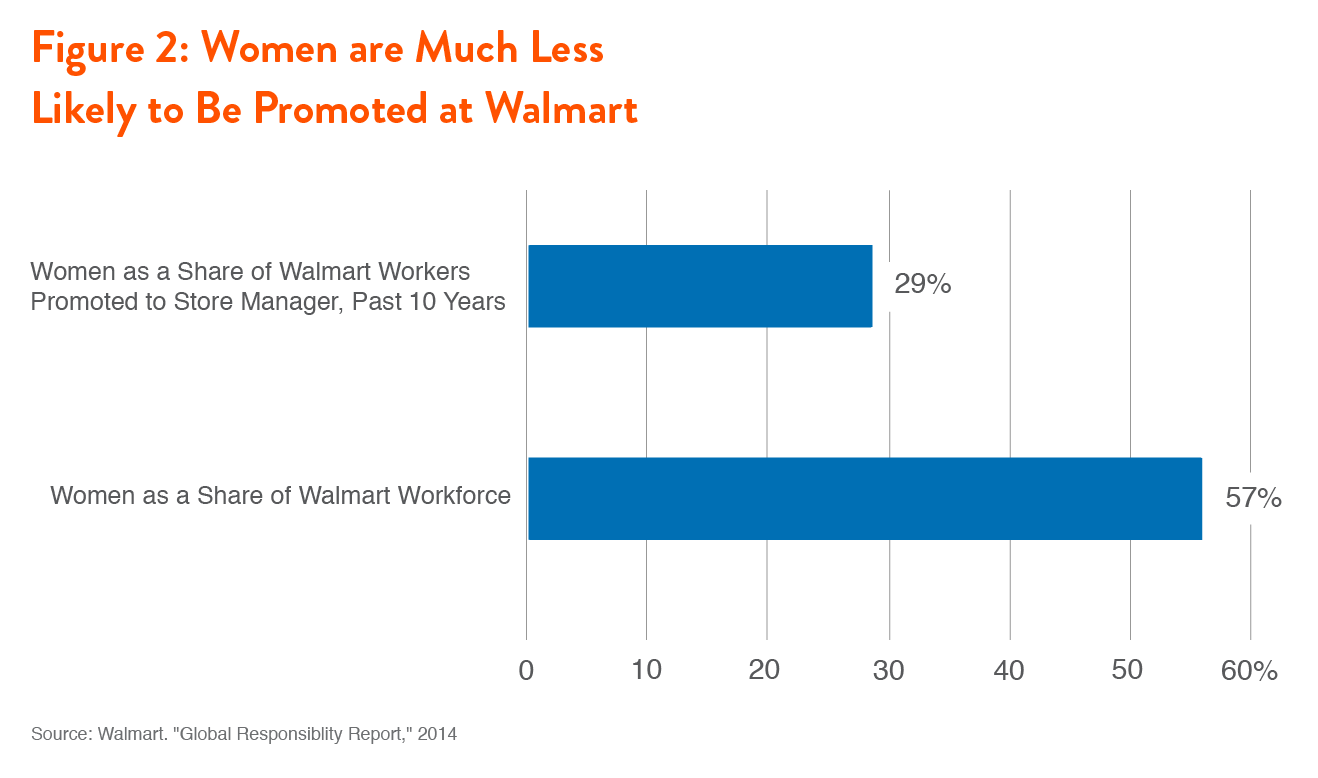In April 2015, Walmart implemented a $9 an hour minimum wage for all of its 1.3 million U.S. workers, and committed to pay all current workers at least $10 per hour by February 2016.1 This is an important step from the country’s largest employer and in particular for the retail industry, where low-wage, unstable employment is the norm. The raise is particularly welcome news for women, who make up 49 percent of the retail industry’s 16.6 million workers, but 55 percent of its low-wage workers.2 However, the industry needs to do more to ensure that retail jobs are good jobs, particularly for women, on whom its unfair and unpredictable scheduling practices fall the hardest. Walmart, with more than 800,000 female employees in the United States,3 has the unique opportunity to lead the industry by committing to a living wage and a comprehensive, fair scheduling policy.
The Gender Pay Gap and Women in Poverty
Women earn less than men across nearly every occupation and industry, but the gender pay gap in retail is particularly stark. Lower pay among women in retail contributes to over a million female retail workers living in or near poverty, and makes it difficult for the millions of families who rely on these women’s paychecks.
- Among full-time retail salespersons, the most common occupation in the country, women earn just 68 cents for every dollar earned by a man performing the same job (see Figure 1). In comparison, across all occupations, full-time female workers earn 82 cents for every dollar earned by full-time male workers.
- That means that a female retail salesperson must work nearly an additional six months in order to catch up to what a man earns in one year.4
- More than 1.3 million women working in the retail industry live in or near poverty (earning 150 percent or less of the federal poverty level).5
- One-in-five female retail workers in low-wage jobs is their family’s sole breadwinner; 2-in-5 account for at least half of their family’s income.

Shifty, Sparse Schedules
The variable, unpredictable work schedules frequently endured by retail workers are a particularly heavy burden for female workers, many of whom are also the point persons for family care. Schedules that vary from day-to-day and week-to-week, and given with little advance notice, are often nearly impossible to reconcile with the time-sensitive nature of many family responsibilities.
- One-in-five female retail workers want full-time hours but only get part-time work.7
- Eighty-seven percent of young retail workers saw their hours vary in the past month, and 50 percent knew their schedule a week or less in advance.8
- These variable schedules are especially a problem for workers with family care responsibilities, the majority of whom are women. These responsibilities make lack of paid sick time and family leave, and unpredictable schedules problems that impact the whole family.
Walmart’s Chance to Change Working Women’s Lives
As the country’s largest retailer and biggest employer of women in the private sector, Walmart’s wages and employment practices set a standard followed by many other large employers. Walmart therefore has a unique opportunity to lead by example by creating a working environment that is fair and sustainable for all of its workers. Raising its employees’ pay is a good first step, but additional policy changes are needed for Walmart to truly be a model employer.
- Opportunity gap: At Walmart, over the past 10 years just 29 percent of those promoted to store manager have been women, despite the fact that 57 percent of the company’s workforce is female (see Figure 2).9
- Wages: Though its commitment to pay most workers $10 an hour by next year is a good start, Walmart still has the capacity to raise wages by more than $5 per hour for all of its low-wage employees just by reallocating current profit expenditures.10
- Part-timers’ pay: Women are more likely to work in part time positions, which are lower paid.11 One important reform that Walmart could implement which would help to close the gender pay gap would be to commit to paying part-time employees the same wage as full-time employees if they perform the same jobs.
- Schedules: Along with the higher minimum wage, Walmart recently promised that its employees will know their schedules at least 2.5 weeks in advance, as well as increased scheduling stability.12 However, further reform of its scheduling policy—particularly a guarantee of full-time schedules for those who want them, and using modern scheduling software to account for workers’ scheduling needs—is needed to make Walmart a leader on ensuring that retail jobs are good jobs.

Fair Treatment Is the Law
Workers and employers, like Walmart, should be mindful of potential legal claims when company policies or practices operate to discriminate—intentionally or inadvertently—against women. Women who perform essentially the same function as men must be paid equally for their work and women must have the same opportunities for advancement as men. This means, for example, a woman categorized as part-time must be paid the same as a man categorized as full-time if both employees have equivalent job responsibilities and perform equivalent work. Walmart should ensure that its policy of paying part-time workers—most of whom are women and many of whom want to work full-time—at a lower hourly rate than full-time workers is not causing an unlawful pay disparity between its male and female workers.
Endnotes
- Walmart, “Walmart to Increase Wages for Current U.S. Workers to $10 an Hour or Higher, Launches New Skills-Based Training for Associates,” 2015, http://cdn.corporate.walmart.com/a1/0e/6fec066e4cf48b9ec4b9f09bcd67/associate-opportunity-fact-sheet.2.pdf.
- Amy Traub, Retail’s Choice: How Raising Wages and Improving Schedules For Women in the Retail Industry Would Benefit America, 2014, http://www.demos.org/publication/retails-choice-how-raising-wages-and-improving-schedules-women-retail-industry-would-ben.
- Walmart, 2014 Global Responsibility Report, 2014, http://cdn.corporate.walmart.com/db/e1/b551a9db42fd99ea24141f76065f/2014-global-responsibility-report.pdf.
- Bureau of Labor Statistics, Women in the Labor Force: A Databook, 2014, http://www.bls.gov/opub/reports/cps/women-in-the-labor-force-a-databook-2014.pdf.
- Amy Traub, Retail’s Choice.
- Ibid.
- Ibid.
- Susan Lambert, et al., “Precarious Work Schedules Among Early-Career Employees in the U.S.,” 2014, http://ssascholars.uchicago.edu/work-scheduling-study/files/lambert.fugiel.henly_.precarious_work_schedules.august2014.pdf.
- Walmart, 2014 Global Responsibility Report, pp. 23-24
- Amy Traub, Retail’s Choice.
- Walmart, “Walmart to Increase Wages for Current U.S. Workers to $10 an Hour or Higher.”
- Ibid.